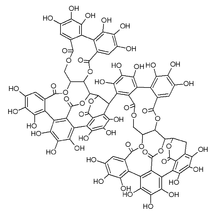| Revision as of 21:04, 21 June 2019 editEdgar181 (talk | contribs)Extended confirmed users196,325 editsm deprecated stub category (via WP:JWB)← Previous edit | Revision as of 00:45, 19 August 2019 edit undoGyimhu (talk | contribs)Extended confirmed users4,063 editsNo edit summaryNext edit → | ||
| Line 13: | Line 13: | ||
| | CASNo = 132864-75-6 | | CASNo = 132864-75-6 | ||
| | CASNoOther = | | CASNoOther = | ||
| | PubChem = | | PubChem = 355200701 | ||
| | ChemSpiderID = 68024617 | |||
| | SMILES = | | SMILES = | ||
| | InChI = | | InChI = | ||
Revision as of 00:45, 19 August 2019

| |
| Identifiers | |
|---|---|
| CAS Number | |
| ChemSpider | |
| PubChem CID | |
| Properties | |
| Chemical formula | C82H50O51 |
| Molar mass | 1851.251 g·mol |
| Except where otherwise noted, data are given for materials in their standard state (at 25 °C , 100 kPa).
| |
Roburin A is a tannin found in oak wood (Quercus robur and Quercus petraea or Quercus alba) or oak cork (Quercus suber).
It is a dimeric compound, composed of two vescalagin subunits probably linked through an ether bond between the diphenoyl group (hexahydroxydiphenic acid or HHDP) of one subunit and the triphenoyl moiety (nonahydroxytriphenic acid) of the other one.
References
- Mosedale, J R; Feuillat, F; Baumes, R; Dupouey, J-L; Puech, J-L (1998). "Variability of wood extractives among Quercus roburand Quercus petraeatrees from mixed stands and their relation to wood anatomy and leaf morphology". Canadian Journal of Forest Research. 28 (7): 994–1006. doi:10.1139/x98-066.
- Glabasnia, Arne; Hofmann, Thomas (2007). "Identification and Sensory Evaluation of Dehydro- and Deoxy-ellagitannins Formed upon Toasting of Oak Wood (Quercus alba L.)". Journal of Agricultural and Food Chemistry. 55 (10): 4109–18. doi:10.1021/jf070151m. PMID 17444655.
- Cadahía, Estrella; Conde, Elvira; Fernández De Simón, Brígida; García-Vallejo, María Concepción (1998). "Changes in Tannic Composition of Reproduction Cork Quercus suberthroughout Industrial Processing". Journal of Agricultural and Food Chemistry. 46 (6): 2332–6. doi:10.1021/jf9709360.
- Herve du Penhoat, Catherine L.M.; Michon, Veronique M.F.; Ohassan, Abdelhamid; Peng, Shuyun; Scalbert, Augustin; Gage, Douglas (1991). "Roburin A, A dimeric ellagitannin from heartwood of Quercus robur". Phytochemistry. 30: 329–32. doi:10.1016/0031-9422(91)84148-L.
This article about an aromatic compound is a stub. You can help Misplaced Pages by expanding it. |